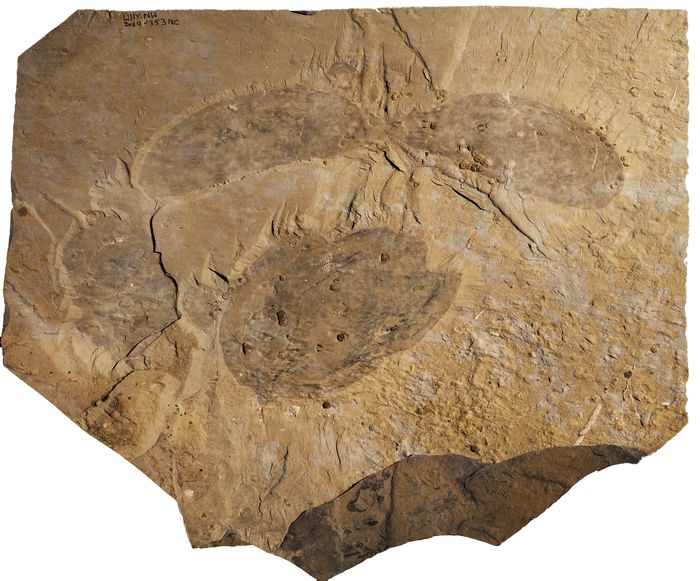Caron & Moysiuk
–
Graphic reconstruction of Titanokorys gainesi, an ancient arthropod from 500 million years ago or the Cambrian period.
–
Nationalgeographic.co.id—Life in the sea seems to keep a variety of mysteries. Researchers have found fossils of an unusual creature that is thought to be gigantic compared to marine life 500 million years ago.
Reported from CNN, the new fossil discovered by researchers is Titanokorys gainesi, ancient animal which is up to half a meter in length. This size is very large considering that other sea creatures are the size of a little finger.
Titanokorys gainesi enter the order Radiodonta, group arthropods primitive species that became widespread after the Cambrian explosion, 541 million years ago. The Cambrian Explosion is an event that occurs in the emergence of phyla and species in a relatively short time.
Fossil Titanokorys gainesi found in Cambrian rocks in Kootenay National Park, Canada. This discovery managed to amaze experts, Jean-Bernard Caron as the lead author of the study from Royal Ontario Museum’s Richard M. Ivey Curator of Invertebrate Palaeontology in his statement revealing the size of this truly mind-boggling animal and one of the largest animals from the Cambrian period ever found.
This animal has diverse eyes, a mouth shaped like a pineapple wedge lined with teeth and spiked claws under its head to catch prey. Its body is equipped with a series of folds that help it swim. Not only that, Titanokorys gainesi have a large head carapace, like the shell of a crab or turtle.
Also Read: Cowherd Finds 20,000 Years Old ‘Dinosaur Shells’

J.-B. Caron y J. Moysiuk
–
Titanokorys gainesi, is an ancient animal that reaches half a meter in length. This size is fairly large compared to marine animals at that time.
–
“Titanokorys are part of a subgroup of radiodonta called hurdiids, characterized by very long heads covered in a three-part carapace of varying shape,” said Joe Moysiuk, a colleague of Jean-Bernard Caron.
The study on Titanokorys gainesi has been published in The Royal Society Publishing by title A giant nektobenthic radiodont from the Burgess Shale and the significance of hurdiid carapace diversity on September 8, 2021. Researchers are still trying to understand why some radiodonta have head carapace that vary from shape to size. In the case of Titanokorys, the wide and flat carapace indicates that this animal has adapted to live near the ocean floor.
“This mysterious animal certainly had a great impact on the seabed ecosystem in the Cambrian period. Their forelimbs look like several stacked rakes and are very efficient at carrying whatever they catch on the tiny spines near the mouth. The large dorsal carapace probably functions like a plow,” explains Jean-Bernard Caron.
Also Read: Kurupi itaata, New Predator Dinosaur Found in Brazil

Royal Ontario Museum
–
Paleontologist Jean-Bernard Caron of the Royal Ontario Museum sits on a Titanokorys gainesi fossil at a mine site located in Kootenay National Park, British Columbia, Canada.
–
The name Titanokorys itself means “titanic helmet” Quoted from ABC, this name represents the anatomy of this creature whose head is two-thirds the size of its body. Some of the fossils of this ancient animal were found between 2014 and 2018.
Titanokorys gainesi seems to eat the animals buried in the ground like worms. They use their claws to stir the mud and filter it. Their claws are not adapted for catching prey, but for bringing food to the mouth.
Also Read: Another One, Explanation of Cambodian Dinosaur Puzzles at Ta Prohm . Temple

Jean-Bernard Caron/Royal Ontario Museum
–
The carapace of Titanokorys gainesi (bottom) together with two symmetrical plates (top) covering the head from below. Forms a set of three pieces of ‘armor’ that protects the head from all sides.
–
Joe Moysiuk said these animals probably swam like stingrays today. Titanokorys gainesi live together with various types of arthropods, worms, and small fish Metaspiggina.
Where to find fossils Titanokorys gainesi namely Marble Canyon, the northern part of Kootenay National Park is where many Cambrian fossils are found. Furthermore, Titanokorys gainesi fossils and other fossils collected from the Burgess Shale will be on display in the new gallery of the Royal Ontario Museum in December.
This site is part of the Burgess Shale, a place where fossils are well preserved in the Rocky Mountains, Canada. The Burgess Shale is a UNESCO World Heritage Site, one of the discoveries from the area is Cambroraster falcatus.
Also Read: Giant Tortoise Egg Fossil Reveals Hatchling Embryos Inside
PROMOTED CONTENT
Featured Videos
– .


